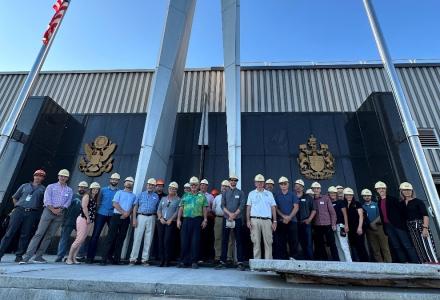
In the Great Lakes, we are fortunate to live by large bodies of freshwater that can be used for many activities and essential needs, including drinking water, recreation and transportation. However, with summer underway, we will soon see blooms of cyanobacteria - commonly called blue-green algae – in our shallower bays.
These Harmful Algal Blooms - or HABs - are caused by nutrient pollution -- such as phosphorus in fertilizers that runs off of agricultural fields and lawns -- and other factors such as water temperature and circulation. The blooms can produce toxins and when they eventually die and decompose, can cause oxygen levels in the water to decrease. Less oxygen threatens the health of fish and other aquatic organisms. HABs also can sicken people and animals through contact. This form of excessive algae can therefore have many negative impacts on the ecosystem.

HABs management is a perfect example of a complex, regional challenge that cannot be addressed by traditional approaches. With that in mind, the Great Lakes HABs Collaboratory was established in 2015 by the Great Lakes Commission in partnership with U.S. Geological Survey’s Great Lakes Science Center to coordinate HABs prevention and control across the Great Lakes region.  The Great Lakes HABs Collaboratory is a multidisciplinary group with more than 100 members from government, academia, and other sectors from across the Great Lakes. As the title implies, this group applies the concept of a “collective laboratory” to enable science-based information sharing between scientists, as well as between scientists and managers.
The Great Lakes HABs Collaboratory is a multidisciplinary group with more than 100 members from government, academia, and other sectors from across the Great Lakes. As the title implies, this group applies the concept of a “collective laboratory” to enable science-based information sharing between scientists, as well as between scientists and managers.
The Collaboratory recently launched a “state of the science” webinar series to improve communication and enhance collaboration between researchers working on HABs. The webinars are free and open to the public, and are recorded for listening after the actual presentation date. You can learn more at www.glc.org/projects/water-quality/habs/.
This webinar series, organized in partnership with Ohio Sea Grant and LimnoTech, has a speed-talk format with five-minute presentations from five to eight researchers in a one-hour period. Webinars are planned throughout the summer and expected to continue through September. They will touch on many different subjects related to HABs.
The first webinar on June 2 focused on “HABs Data & Modeling,” and included presentations on data and buoys in Lake Erie from Doug Kane of Defiance College and on real-time monitoring in western Lake Erie from Ed Verhamme of Limnotech (to learn more and see the Great Lakes Observatory System HABs Data Portal, click here).
Also presenting was Brian Roe of the Ohio State University on Ohio residents’ willingness to pay to reduce Lake Erie HABs, and Isabella Bertani of Michigan State University spoke about synthesizing different monitoring approaches in the western basin. Additional modeling efforts were shared by Val Klump of the University of Wisconsin – Milwaukee, who discussed a Green Bay watershed linked model, and John Bratton of Limnotech, who presented models to link HABs and conditions in the lakes. A recording and presentations from the webinar are available here.
A second webinar on June 23 focused on “HABs Blooms Sources & Movements” (click here to see the recording and presentations). Excessive phosphorus in the ecosystem is a well-known cause of HABs blooms; however, many researchers are now looking at the effects of nitrogen on HABs blooms. Kateri Salk of Michigan State University and Silvia Newell of Wright State University both discussed this linkage.
Additionally, Mike McKay of Bowling Green State University presented on the HABs detection, mapping and warning network in Sandusky Bay, and Mark Rowe of University of Michigan presented an update on improvements to the National Oceanic and Atmospheric Administration's HAB Tracker. Bart De Stasio of Lawrence University discussed changes in Green Bay’s food web after invasion by zebra mussels.
The July 19 webinar focused on composition, structure, detection and identification of HABs. Recordings of all past webinars are available online at www.glc.org/projects/water-quality/habs/, as well as registration for future webinars in August and September. Melanie Adam is a biologist and an engineering student serving as an intern for the Great Lakes Commission, where she works primarily on water quality issues, including HABs and water quality trading.

Melanie Adam is a biologist and an engineering student serving as an intern for the Great Lakes Commission, where she works primarily on water quality issues, including HABs and water quality trading.





